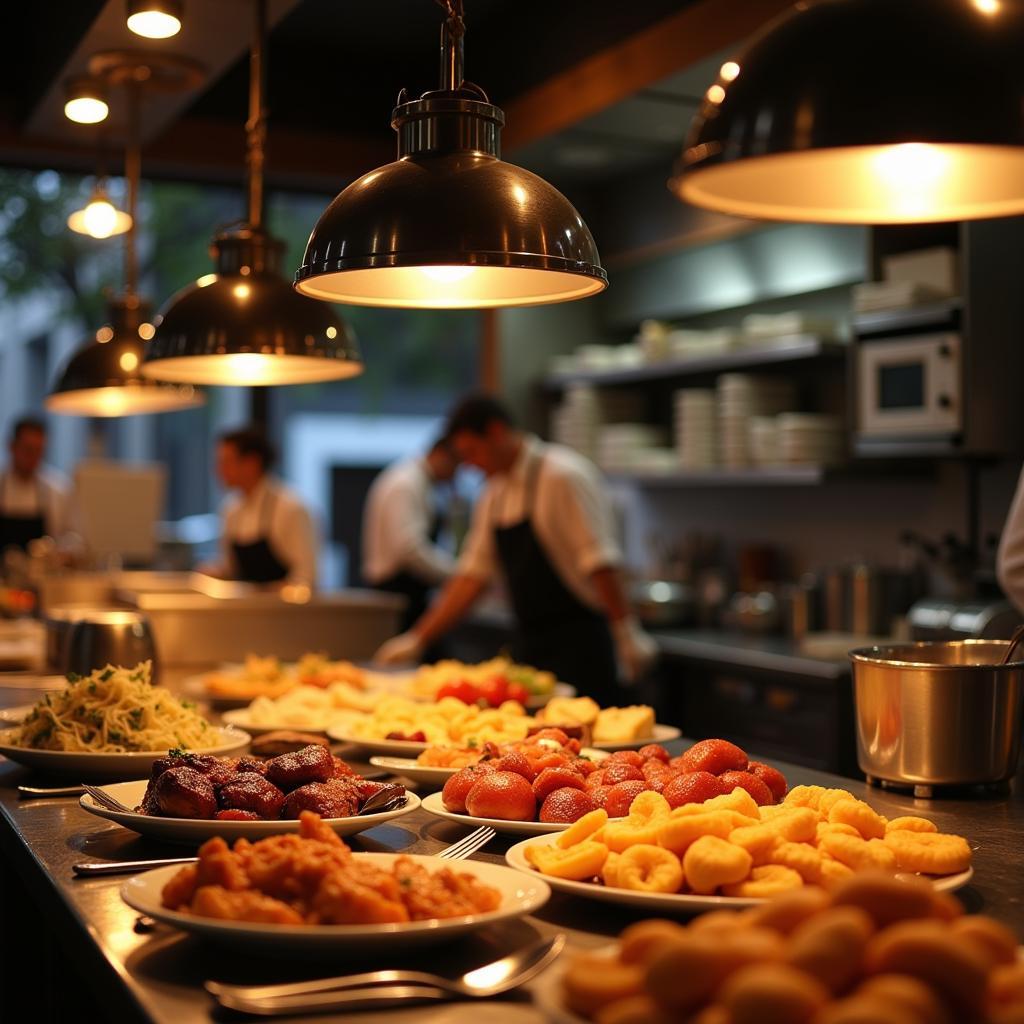Heat Lamps For Food Warming have become an indispensable tool for any business looking to maintain the optimal serving temperature of their dishes. Whether you’re running a bustling restaurant, a cozy cafe, or even a food truck, understanding the nuances of food warming heat lamps can make a world of difference in customer satisfaction and food safety.
Why Choose Heat Lamps for Food Warming?
 Restaurant Kitchen with Heat Lamps for Food Warming
Restaurant Kitchen with Heat Lamps for Food Warming
Heat lamps, especially the top-tier food warming heat lamps, offer a compelling combination of functionality, affordability, and ease of use. Unlike bulky ovens or warming drawers, they provide a focused heat source directly onto your food, ensuring it stays at the perfect temperature without continuing to cook or dry out. They’re incredibly versatile, suitable for keeping everything from appetizers to main courses warm and ready to serve.
Types of Heat Lamps for Food Warming
Navigating the world of heat lamps can seem daunting with the plethora of options available. Let’s break down the most common types to help you make an informed decision:
1. Infrared Heat Lamps
Infrared heat lamps are favored for their ability to penetrate food deeply and evenly, making them ideal for warming thicker items like steaks or casseroles. They emit a gentle, radiant heat that preserves moisture and enhances flavor.
2. Quartz Heat Lamps
Quartz heat lamps are known for their instant heat output, making them perfect for fast-paced environments. They’re particularly effective for warming foods with a crispy exterior, such as french fries or fried chicken.
3. Ceramic Heat Lamps
Ceramic heat lamps provide a gentle, long-lasting heat that’s less intense than infrared or quartz lamps. They’re an excellent choice for delicate foods like pastries or keeping large batches of food warm over extended periods.
Factors to Consider When Choosing Heat Lamps
 Maintaining Correct Distance Between Heat Lamp and Food
Maintaining Correct Distance Between Heat Lamp and Food
Selecting the right heat lamp involves considering various factors to ensure optimal performance:
- Wattage: The wattage of a heat lamp determines its heat output. Higher wattage lamps generate more heat, suitable for larger quantities or thicker foods.
- Bulb Type: As discussed earlier, different bulb types offer varying heat intensities and warming properties. Choose a bulb that aligns with your specific needs.
- Size and Coverage Area: Consider the dimensions of your food preparation area and the number of dishes you need to keep warm simultaneously.
- Adjustability: Heat lamps with adjustable height and angle settings provide greater flexibility, allowing you to customize the heat distribution based on the type and quantity of food.
Benefits of Using Heat Lamps for Food Warming
- Enhanced Food Quality: Heat lamps maintain the ideal serving temperature, preserving the texture, flavor, and visual appeal of your dishes.
- Improved Food Safety: By keeping food out of the “danger zone” temperature range, heat lamps contribute to preventing bacterial growth and foodborne illnesses.
- Increased Efficiency: Heat lamps are energy-efficient compared to traditional ovens, saving you money on electricity bills.
- Versatility: From appetizers to desserts, heat lamps can accommodate a wide range of food items.
- Easy to Use and Maintain: Heat lamps are incredibly user-friendly and require minimal maintenance.
Tips for Using Heat Lamps Effectively
- Maintain Proper Distance: Position your heat lamps at the correct distance from the food to prevent overheating or uneven warming.
- Use Appropriate Covers: Utilize heat-resistant covers or shields to trap heat and create a more controlled warming environment.
- Monitor Food Temperature: Regularly check the internal temperature of your food using a thermometer to ensure it’s being held at a safe and palatable temperature.
- Clean Regularly: Wipe down your heat lamps and bulbs regularly to prevent dust and debris from accumulating and affecting their performance.
Conclusion
Investing in high-quality food warmer equipment like heat lamps is a game-changer for any foodservice operation. They offer a practical and efficient solution for maintaining food quality, enhancing safety, and impressing your customers with perfectly warmed dishes every time. Whether you opt for NSF food warmer certified options or explore the range of countertop food warmers commercial models, remember to prioritize your specific needs and prioritize reliable brands for optimal performance.
FAQs
1. How long can I keep food warm under a heat lamp?
Ideally, food should not be kept under a heat lamp for more than 2 hours. However, always refer to food safety guidelines and use a thermometer to ensure food is held at a safe temperature.
2. Can I use heat lamps to warm cold food?
Heat lamps are best suited for maintaining the temperature of already-hot food. They are not designed to reheat cold food thoroughly and safely.
3. Do heat lamps affect the nutritional value of food?
While heat lamps can cause some nutrient loss over extended periods, the impact is generally minimal compared to other cooking methods.
4. How do I clean my heat lamps?
Allow the lamps to cool completely, then wipe them down with a damp cloth and mild detergent. Avoid abrasive cleaners that can damage the bulbs or surfaces.
5. Are heat lamps energy-efficient?
Yes, heat lamps are generally energy-efficient, especially compared to traditional ovens. Choose LED bulbs for even greater energy savings.
If you need more information on maintaining your food at the perfect temperature, you can check out our website on used bbq food trailers for sale for more resources.
Need assistance? Contact us at Phone Number: 02437655121, Email: [email protected] Or visit us at Address: 3PGH+8R9, ĐT70A, thôn Trung, Bắc Từ Liêm, Hà Nội, Việt Nam. Our customer service team is available 24/7 to assist you.